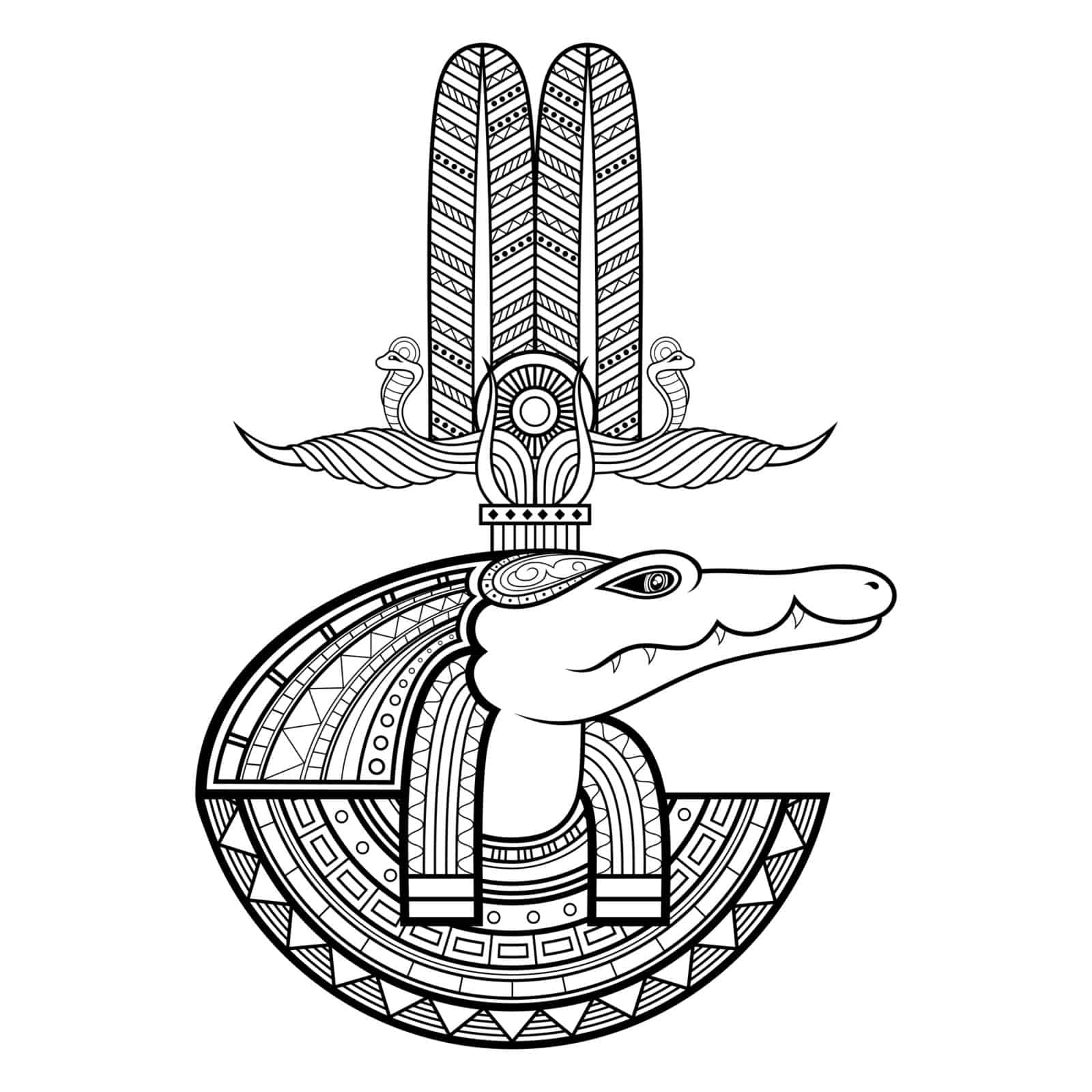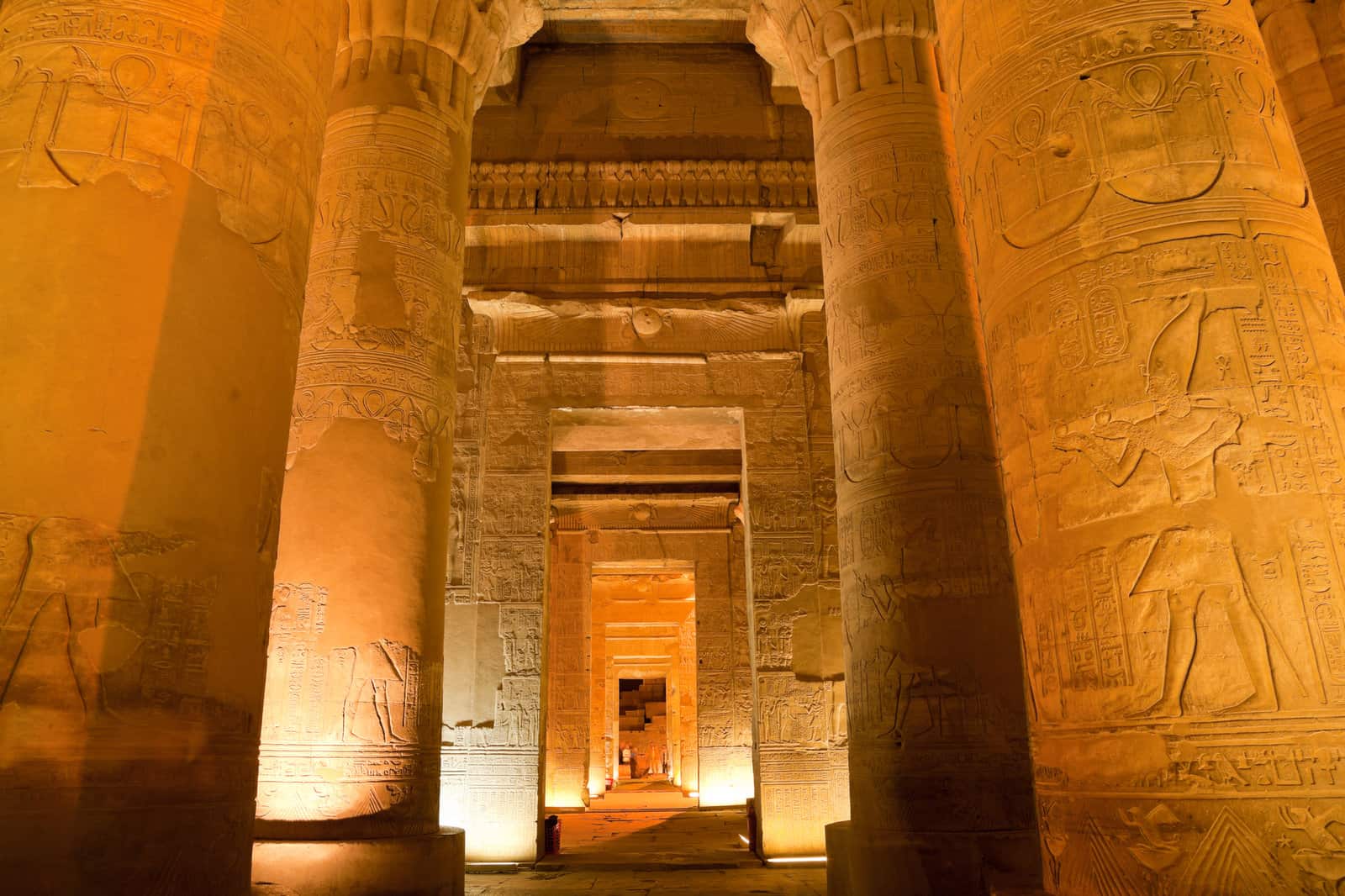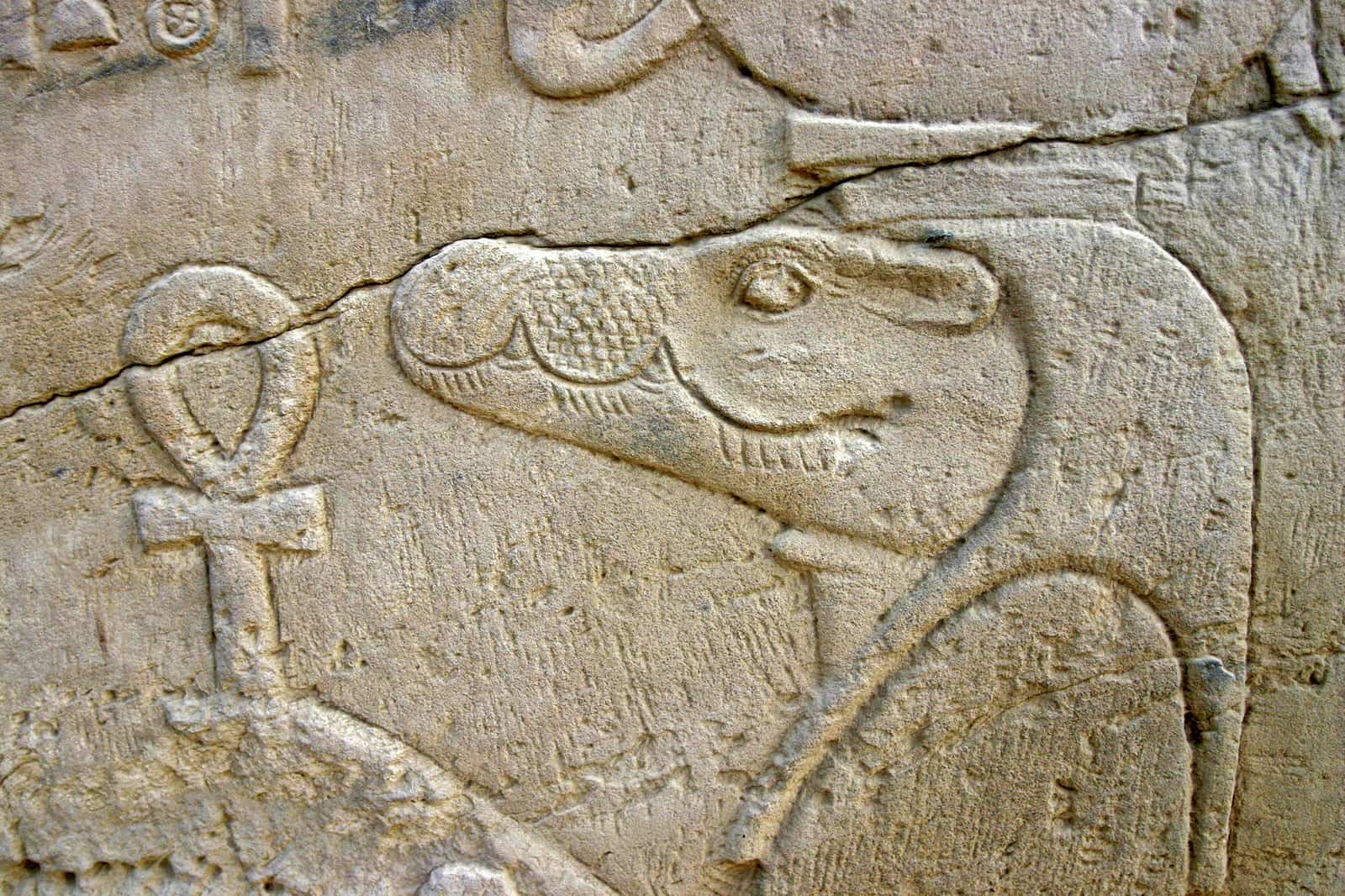
Sobek, 5 Amazing Facts
The God of strength and power in Ancient Egypt
Some myths say that Sobek made the world, and the Egyptians worshipped him as early as the Old Kingdom.
When King Amenemhat III was very interested in the Crocodile God, he became famous in the Middle Kingdom.
This 12th Dynasty King gave Sobek a new look by putting Horus’s face on him.
The God of Crocs
The Temple of Sobek in Kom Ombo
Crocodiles were loved and feared by the people of ancient Egypt, who worshipped them.
They were a sign of power, virility, and the ability to have children.
He was the Crocodile God. He watched over the Egyptian army, the pharaohs, and the people of ancient Egypt.
His courage and strength helped the Pharaoh overcome problems and kept him safe from evil magic.
Sobek first showed up in the Old Kingdom. He is shown as a full crocodile or a human with a crocodile head. The ancient Egyptians kept crocodiles in pools and temples, giving them tasty foods and decorating them with jewels. Mummified crocodiles of all ages, including eggs with foetuses, have been found in tombs.
Because of his dominion over the river and agricultural prosperity, Sobek was worshipped as the Nile’s patron deity. But he was also unpredictable.
He has many names, like “Lord of the Waters,” “The Rager,” and “Lord of Faiyum.” Because of his strength, power, and skill, he is also the patron of the military. Sobek took on the qualities of the Nile crocodile, which the ancient Egyptians both loved and feared.
The Nile River was in charge of the crocodile god Sobek. Hieroglyphs said that the great river flowed as Sobek’s sweat.
He also had a lot of power when it came to medicine, surgery, and sudden deaths.
During the Middle Kingdom, Sobek and Horus joined together to protect the pharaohs. Crocodiles still alive when they died were often put in their temples.
Sobek, Kom Ombo
He was the leader of the crocodiles, so he had a crocodile’s head. Some Ancient Egyptian groups thought that when He came out of the “Dark Water,” he brought order to the universe and the world. They also thought that he made the Nile River. He was often linked to having children.
Sobek is a good god
He is a violent and animalistic god who acts like his favourite animal, the large and dangerous Nile crocodile or West African crocodile.
Is Sobek an evil god?
- Despite what The Red Pyramid says about him, he was not a bad god in Egypt. He was linked to the power of the pharaohs, fertility, and military skill.
Egyptians respected him and prayed to him to keep them safe from the crocodiles that lived on the Nile.
- He is said to have eaten Osiris to make him seem even more like a monster. It wasn’t unusual for gods to eat each other. Crocodiles were only sometimes seen as good, though. Sometimes, people thought they were gods of destruction sent by Set.
Sobek’s weakness
Weaknesses. He is a crocodile, so his underbelly is soft and easy to attack. When his energy is low, he also has trouble fighting people who are stronger than him.
Sobek and Anubis were related.
- To be exact. He is the god of the crocodiles in the Nile and one of Egypt’s gods of medicine.
His wife
- Renenutet, Sobek’s wife, was the Goddess of Plenty and brought the ancient Egyptians luck. Sons: Khonsu, the god of the moon and time, is probably Sobek’s son. He was also sometimes called Khnum and Khonsu’s father.
Sobek controls the water
- Affectionately referred to as “the Lord of Faiyum,” He was considered the god in charge of the water.
Sobek’s symbols
- As Sobek-Ra, the crocodile is his sign, and as Sobek, the sun disc and the uraeus.
- Sobek was the leader of the crocodiles, and some people thought he was the one who put the order in the universe.
- Sobek was a crocodile god. He was shown as a crocodile on an altar or as a man with a crocodile’s head who wore a sun disk-shaped headdress with feathers and horns sticking up.
Something interesting about Sobek
Crocodiles and water were both sacred to the ancient Egyptian god Sobek.
Sobek’s job was to keep the pharaoh safe from evil, but how he did that depended on the person. He was the most well-known god in Arsinoe (Greek: Crocodilopolis) and was known as the Lord of Faiyu (a place in Egypt).
In the Pyramid Texts written on the walls of tombs, He was given a prominent place as one of the universe’s first gods.
Since he was the leader of the crocodiles, he had the head of a crocodile to show what he looked like.
Many people in ancient Egypt thought that when Sobek came out of the “Dark Water,” he brought order to the world and the universe.
People also thought that he was the one who made the Nile River.
He was often talked about in terms of being a dad.
Even though Sobek was respected for being fast and fierce, he was also unpredictable, just like the crocodiles he looked up to.
He was sometimes linked to the idea of chaos.
Ancient Egyptians thought that if they worshipped Sobek, they would make him and all other crocodiles happy and ensure that their people and crops would do well.
In tombs all over Egypt, many mummified crocodiles of different ages and sizes were found.
He was very close to his father, Seth, and his son, Horus, whom he helped bring into the world.
Because he was so fierce, many people in the army looked to him as their leader.
He is the god of strength and power in ancient Egypt.
He has some of the following:
Fighting and being mean (That’s why people associate him with military skill),
Strength and Power (military skill, bodyguard of the Pharaoh).
Ancient people thought he could help them get better after a bad time because he could give the dead new eyes and senses—Protective (his fierceness kept away evil and kept the good people safe).
Sobek’s Family Tree Is Not So Reptilian
Father: I’m Set, the god of thunder, storms, war, and chaos.
Neith was the mother. She was the goddess of war, hunting, and knowledge.
Renenutet, His wife, was a deity of plenty. She brought luck to the ancient Egyptians.
Sons: Khonsu, the moon and time god, is most likely Sobek’s son. He was also called Khnum and Khonsu’s father from time to time.
Cohorts: Besides his wife, Hathor, Heqet, and Taweret were in the same group.
Crocodilopolis and other places where cults meet
He was worshipped in several places, but the three most important ones were:
The Greeks changed the name of
1-Shedyet to Crocodilopolis. Petsuchos, a real crocodile, was a god to the ancient Egyptians (his son). They put valuable gems on Petsuchos and only gave him the best foods. Petsuchos made his home in a temple surrounded by sand and a lake. The ancient people turned his body into a mummy when the crocodile died.
After that, he was quickly replaced by someone else.
2-Nubt: The Greeks changed the name of this ancient city in Upper Egypt from Nubt to Kom Ombo. It was a busy military base that controlled trade routes.
Crocodiles that were still alive were kept at the Sobek temple, which was a very holy place.
3-Karanis: This cult centre was built in the northeast corner of Fayum when the Romans were in charge. It was there until the year 380 when Emperor Constantine the Great took over.
Because of his association with the crocodiles of the Nile, Sobek, the Egyptian crocodile god, held a significant place in Egyptian mythology. All sorts of mundane, day-to-day things required his attention. A closer inspection of his legend follows.
Sobek was an old god in Egyptian mythology and one of the most important.
He is mentioned in the Pyramid Texts, a group of texts found in Old Kingdom tombs. It’s possible that the Ancient Egyptians worshipped him all over the land, even at this time.
Sobek, whose name meant “crocodile,” was the god of crocodiles and water.
He was usually shown as an animal or as a human with a crocodile head. Besides being the leader of the crocodiles.
He was also known for being strong and powerful. Sobek was in charge of protecting the army and the Pharaohs. People thought of him as the God Hopi, a fertility god, because he was linked to the Nile.
Sobek’s Origins
Myths about where Sobek came from and who his parents were are very different.
- In the Pyramid Texts, Sobek was described as Neith’s son. Neith was an ancient Egyptian god. In these stories, Sobek was the most important person in the world’s creation because he laid most of the eggs on the banks of the Nile.
- Some other stories say He came from the waters of Nun, which were very old. He came from what is called the Dark Waters. He gave the world its order and made the Nile by being born.
- Other stories say that Sobek is the son of either Khnum, the god of the Nile’s source, or Set, the god of chaos. He was also one of his followers during the fights for Egypt’s throne.
Sobek’s Role in Ancient Egypt
He seems to be a significant figure in the early myths, and from the Old Kingdom to the Middle Kingdom, people worshipped him for a long time.
During the Middle Kingdom, when Pharaoh Amenemhat III was in charge, worship of Sobek became more popular.
The Pharaoh started building a temple for worshipping Sobek.
Amenemhat IV, who came after him, finished the temple.
Sobek and Having Children
He was a god to the ancient Egyptians because he made sure that the land was fertile.
People thought that because he was the god of the Nile, he could make crops, animals, and people do well.
In these stories, Sobek gave Egypt all of its children.
Sobek’s Dark Side
He sided with Set when he and his brother Osiris fought over who should be king of Egypt.
In the end, Set took the throne and killed and disfigured his brother Osiris. Sobek was a violent person because he was a crocodile, but this didn’t make him evil as much as it made him powerful.
He is a symbol of authority as well as fertility and protection.
In Brief,
Sobek’s story evolved through time to become more significant, despite the fact that he was not initially considered to be one of the most important gods in the Egyptian pantheon.
He was a remarkable figure in Ancient Egyptian culture because of the Nile’s central role in the country.
He was a god who was both protective and generous, and he was very powerful. His widespread presence in the worship of the people can be attributed to the fact that he is associated with fertility.
Groups and Groups of Three
Horus were very close to Sobek.
He is often considered a part of Horus because Horus turned into a crocodile to help Osiris’s body parts get back to him.
And yet, people thought that Sobek helped Isis give birth to Horus. He joined the Osirian Triad, which is made up of Osiris, Isis, and Horus, because he was close to Horus.
During the New Kingdom, He was worshipped as the personification of Amun-Ra, the King of Gods, and was part of the cult of Amun.
Sobek was often shown wearing the headdress of Amun or the sun disc of Ra.
Within the Triad of Kom Ombo, Sobek was one of the three deities worshipped. Along with Hathor and Khonsu.
Temples were built there between 300 and 380 BC, and one can still be seen today.
This was all about Sobek, The God of Strength, the Crocodile. To learn more about other gods and more interesting information, keep visiting Learningmole.
If you enjoyed this article – Why not subscribe to our LearningMole Library for as little as £1.99 per month to access over 1000 fun educational videos.





Leave a Reply